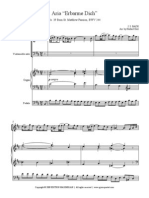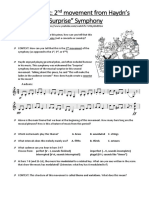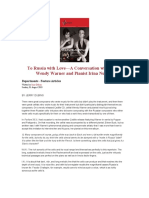0 ratings0% found this document useful (0 votes)
81 viewsCapriccio For Piano and Orchestra Igor Stravinsky: in Short
Capriccio For Piano and Orchestra Igor Stravinsky: in Short
Uploaded by
Davi Raubach TuchtenhagenStravinsky wrote his Capriccio for Piano and Orchestra in 1928-1929. Though titled a "capriccio", the work has elements of a concerto, with the piano playing a featured role alongside contrasting orchestral sections reminiscent of a Baroque concerto grosso. Stravinsky began by writing the lively third movement before settling on the title Capriccio. The piece showcases Stravinsky's piano skills and features an irreverent, jazz-influenced style. It received praise from composers like Poulenc and Thomson upon its premiere, though Stravinsky had difficult relationships with some conductors, like Furtwängler, when performing the work.
Copyright:
© All Rights Reserved
Available Formats
Download as PDF, TXT or read online from Scribd
Capriccio For Piano and Orchestra Igor Stravinsky: in Short
Capriccio For Piano and Orchestra Igor Stravinsky: in Short
Uploaded by
Davi Raubach Tuchtenhagen0 ratings0% found this document useful (0 votes)
81 views2 pagesStravinsky wrote his Capriccio for Piano and Orchestra in 1928-1929. Though titled a "capriccio", the work has elements of a concerto, with the piano playing a featured role alongside contrasting orchestral sections reminiscent of a Baroque concerto grosso. Stravinsky began by writing the lively third movement before settling on the title Capriccio. The piece showcases Stravinsky's piano skills and features an irreverent, jazz-influenced style. It received praise from composers like Poulenc and Thomson upon its premiere, though Stravinsky had difficult relationships with some conductors, like Furtwängler, when performing the work.
Original Description:
www
Original Title
www
Copyright
© © All Rights Reserved
Available Formats
PDF, TXT or read online from Scribd
Share this document
Did you find this document useful?
Is this content inappropriate?
Stravinsky wrote his Capriccio for Piano and Orchestra in 1928-1929. Though titled a "capriccio", the work has elements of a concerto, with the piano playing a featured role alongside contrasting orchestral sections reminiscent of a Baroque concerto grosso. Stravinsky began by writing the lively third movement before settling on the title Capriccio. The piece showcases Stravinsky's piano skills and features an irreverent, jazz-influenced style. It received praise from composers like Poulenc and Thomson upon its premiere, though Stravinsky had difficult relationships with some conductors, like Furtwängler, when performing the work.
Copyright:
© All Rights Reserved
Available Formats
Download as PDF, TXT or read online from Scribd
Download as pdf or txt
0 ratings0% found this document useful (0 votes)
81 views2 pagesCapriccio For Piano and Orchestra Igor Stravinsky: in Short
Capriccio For Piano and Orchestra Igor Stravinsky: in Short
Uploaded by
Davi Raubach TuchtenhagenStravinsky wrote his Capriccio for Piano and Orchestra in 1928-1929. Though titled a "capriccio", the work has elements of a concerto, with the piano playing a featured role alongside contrasting orchestral sections reminiscent of a Baroque concerto grosso. Stravinsky began by writing the lively third movement before settling on the title Capriccio. The piece showcases Stravinsky's piano skills and features an irreverent, jazz-influenced style. It received praise from composers like Poulenc and Thomson upon its premiere, though Stravinsky had difficult relationships with some conductors, like Furtwängler, when performing the work.
Copyright:
© All Rights Reserved
Available Formats
Download as PDF, TXT or read online from Scribd
Download as pdf or txt
You are on page 1of 2
Capriccio for Piano and Orchestra
Igor Stravinsky
Igor Stravinsky felt no compunction about
adding to the literature of such time-
honored genres as the symphony or the
thority of the eighteenth [sic] century. He
regarded it as a synonym of the fantasia,
which was a free form made up of fugato in-
concerto; but, radical musical thinker that strumental passages. This form enabled me
he was, he allowed himself the leeway to to develop my music by the juxtaposition of
rethink basic assumptions when he did in- episodes of various kinds which follow one
volve himself in those classic types. His list another and by their very nature give the
of works includes three items “in the pia- piece that aspect of caprice from which it
no concerto line,” but each departs in an takes its name.
obvious way from the classic formula of a
piano concerto. The one he actually titled He shared his work-in-progress with Sergei
Concerto (from 1923–24) is indeed a piano Prokofiev and Ernest Ansermet when they
concerto, but the accompanying ensemble dropped in to visit him during the summer of
consists only of winds, timpani, and dou- 1928, explaining that he was deriving inspi-
ble bass, rather than a standard symphony ration from the music of Carl Maria von We-
orchestra. The work he originally named ber. (In Dialogues and a Diary, he observed
Concerto for Piano and Groups of Instru- that Weber’s piano sonatas “may have exer-
ments was re-titled Movements (1958–59), cised a spell over me at the time I composed
and its serial processes do not involve the my Capriccio; a specific rhythmic device in
contrast between piano and “accompany- the Capriccio may be traced to Weber, at any
ing” ensemble one expects in a concerto. rate.”) Prokofiev passed on word to his friend
In between those two he wrote the Capric- Nikolai Miaskovsky, saying that Stravinsky
cio (1928–29), in which the piano does play
a concertante role but also works within a IN SHORT
framework of contrasting orchestral units
that harks back to the make-up of a Baroque Born: June 17, 1882, in Oranienbaum, now
concerto grosso. Stravinsky had been in Lomonosov, near St. Petersburg, Russia
demand as a soloist in his Concerto since Died: April 6, 1971, in New York City
unveiling it several years earlier, and this
Work composed: December 1928–November 9,
emboldened him to have a go at another
1929; revised slightly in 1949
work in which he might showcase himself as
pianist. Or, as he put it in his Autobiography: World premiere: December 6, 1929, at the
Salle Pleyel, Paris, by the Paris Symphony
Orchestra, Ernest Ansermet, conductor, with
I had so often been asked in the course of
the composer as soloist
the last few years to play my Concerto … that
I thought that it was time to give the public New York Philharmonic premiere:
another work for piano and orchestra. That January 14, 1937, with the composer as
conductor, Beveridge Webster, soloist
is why I wrote another concerto, which I
called Capriccio, that name seeming to in- Most recent New York Philharmonic
dicate best the character of the music. I had performance: March 6, 2012, David Zinman,
in mind the definition of a capriccio given conductor, Peter Serkin, soloist
by Praetorius, the celebrated musical au- Estimated duration: ca. 18 minutes
32 | NEW YORK PHILHARMONIC
was determined not to call it a concerto so beginning quickly yields to a double-reed
as to avoid a repeat of the charges of insuf- texture that begs comparison to the deep-
ficient virtuosity that critics had leveled at oboe writing of Bach’s Passions, but then a
his earlier piano concerto. He was thinking central section erupts in hysterical panic.
of calling it a divertimento until (according Francis Poulenc wrote an admiring review
to Prokofiev) he learned that Prokofiev and of the Capriccio in 1931, and obviously its
Miaskovsky were both writing pieces under content stuck with him. He all but quoted
that title just then, at which point he veered a couple of passages in his own concertos,
away from that idea, too. particularly in his Organ Concerto of 1938.
Stravinsky began by composing the third Another admiring composer was Virgil
movement, the Allegro capriccioso; the idea Thomson, who judged Stravinsky’s Capriccio
of “capriccio” was therefore embedded in to be “jolly and brilliant.”
the score from the outset. Capricious this
music surely is, and irreverent, too, leap- Instrumentation: three flutes (one dou-
ing about with Jazz Age abandon. The first bling piccolo), two oboes and English horn,
movement is not less rambunctious; after two clarinets (one doubling E-flat clarinet
an exchange of pompous, Tchaikovskian and one doubling bass clarinet), two bassoons,
outbursts at the beginning, it settles into four horns, two trumpets, three trombones,
rhythmic punchiness and stops just short tuba, timpani, and strings (including a
of a tango. The second movement is per- “concertino” group of solo violin, viola, cello,
haps the most surprising of all. Its somber and bass), in addition to the solo piano.
Stravinsky and His Conductors
An entire book could be devoted to Stravinsky’s run-ins with con-
ductors. For some reason, his Capriccio engendered more than
its fair share of abrasive encounters, even giving rise to hurtful
incidents involving his devoted champions Ernest Ansermet and
Charles Munch. Since Stravinsky was preternaturally suspicious
of Germans, it comes as no surprise that one of his Teutonic
colleagues, Wilhelm Furtwängler, also came in for a rough
assessment, as reported in Themes and Episodes (1966), one of the
memoirs he prepared with his amanuensis, Robert Craft:
When I played my piano concerto under Furtwängler’s direction
in Leipzig and in Berlin, he was at the height of his reputation
(“the last of the great tradition,” people were saying, though
I thought myself it would be better to call him the first of the Stravinsky and Furtwängler,
small). … A few years after the Berlin performance, while on in an undated photo
vacation in the Villa d’Este at Como, I received a telegram from
Furtwängler requesting first-performance rights to my Capriccio. I replied that the piece had
already been played twenty times (this was in 1931), but that he was welcome to play it for
the twenty-first. I blame his telegram, and my less than perfect sobriety, for the misdemeanor
that has troubled my conscience, though slightly, in the years since. That night, walking be-
tween a pair of “Greek” statues on one of the Villa’s garden paths, I saw that the marble figures
were covered with tourists’ signatures, and took a pen myself and scrawled WILHELM VON DER
FURTWÄNGLER on the gluteus maximus of the most obviously ersatz Apollo.
JANUARY 2019 | 33
You might also like
- BACH, Erbarme Dich, Violin Cello OrganDocument3 pagesBACH, Erbarme Dich, Violin Cello OrganFloyd Reynolds33% (3)
- Blue Ridge Overture - 40 PDFDocument97 pagesBlue Ridge Overture - 40 PDFxotomana100% (1)
- Haydn Surprise SymphonyDocument2 pagesHaydn Surprise SymphonyArthur0% (1)
- Bernstein Second Symphony (Two Pianos Version)Document97 pagesBernstein Second Symphony (Two Pianos Version)liebenstock96100% (2)
- ProgramNotes Stravinsky PulcinellaDocument3 pagesProgramNotes Stravinsky Pulcinellasrdjan_stanic_1No ratings yet
- Stravinsky Capriccio For Piano and Orchestra PDFDocument2 pagesStravinsky Capriccio For Piano and Orchestra PDFDianaNo ratings yet
- Booklet PDFDocument31 pagesBooklet PDFKeith PittmanNo ratings yet
- Pjotr Ilyich Tchaikovsky (1840-1893) : SymphoniesDocument25 pagesPjotr Ilyich Tchaikovsky (1840-1893) : SymphoniesOrlandoSlavNo ratings yet
- Digital Booklet - Tchaikovsky - Symphonies Nos 1-3Document15 pagesDigital Booklet - Tchaikovsky - Symphonies Nos 1-3WeiCheng JiangNo ratings yet
- Vivaldi Concerto Solennita San Lorenzo RV 556 Violino IDocument8 pagesVivaldi Concerto Solennita San Lorenzo RV 556 Violino IDavid Felipe Rendon LunaNo ratings yet
- Prokofiev Violin Concerto No 1Document3 pagesProkofiev Violin Concerto No 1ethan100% (1)
- MSO Program Notes 001Document4 pagesMSO Program Notes 001rossineparucciNo ratings yet
- The Examination of Igor Stravinsky'S Octet For Wind InstrumentsDocument4 pagesThe Examination of Igor Stravinsky'S Octet For Wind InstrumentsDomenico VirgiliNo ratings yet
- Schumann Edition Liner Notes Brilliant ClassicsDocument76 pagesSchumann Edition Liner Notes Brilliant ClassicsPhasma3027No ratings yet
- The Piano Sonatas of Bela Bartok and Igor StravinskyDocument19 pagesThe Piano Sonatas of Bela Bartok and Igor StravinskyMarilina Tzelepi Pateras Mozart100% (1)
- Stravinskys Compositions For Wind Instru PDFDocument13 pagesStravinskys Compositions For Wind Instru PDFMarildaPsilveiraNo ratings yet
- Notes On The Program: Claude DebussyDocument3 pagesNotes On The Program: Claude DebussyPablo SchinkeNo ratings yet
- Elliott Carter, Xenakis, Krenek, Etc. - Stravinsky, A Composers MemorialDocument182 pagesElliott Carter, Xenakis, Krenek, Etc. - Stravinsky, A Composers MemorialMario Mariani100% (1)
- Respighi Church WindowsDocument3 pagesRespighi Church WindowsGiovanni LuigiNo ratings yet
- ProgramNotes Rachmaninov Symphony2Document3 pagesProgramNotes Rachmaninov Symphony2Gerasim PetrosyanNo ratings yet
- Tchaikovsky Symphony5Document3 pagesTchaikovsky Symphony5MarijanaDujovicNo ratings yet
- Concerto For Oboe and Small Orchestra in D Major Richard StraussDocument2 pagesConcerto For Oboe and Small Orchestra in D Major Richard StraussAitor Llim100% (1)
- ProgramNotes Shostakovich ProkofievDocument7 pagesProgramNotes Shostakovich ProkofievbobocelloNo ratings yet
- 100 Years On - Stravinsky On Rite of Spring PDFDocument7 pages100 Years On - Stravinsky On Rite of Spring PDFDavid KosvinerNo ratings yet
- STRAVINSKY - Stylistic MusicDocument25 pagesSTRAVINSKY - Stylistic MusicspinalzoNo ratings yet
- Liner Notes For Primephonic's SELECTED: SpringDocument11 pagesLiner Notes For Primephonic's SELECTED: SpringLogan K. YoungNo ratings yet
- 100 Years On - Igor Stravinsky On 'The Rite of Spring' (Times Literary Suplement)Document15 pages100 Years On - Igor Stravinsky On 'The Rite of Spring' (Times Literary Suplement)HUdsonNo ratings yet
- Nocturne (Fr. of The Night Ger. Nachtstück It. Notturno)Document2 pagesNocturne (Fr. of The Night Ger. Nachtstück It. Notturno)EENo ratings yet
- Booklet - 1984 - Verklärte Nacht (Schönberg Ensemble)Document7 pagesBooklet - 1984 - Verklärte Nacht (Schönberg Ensemble)Daniel VelandiaNo ratings yet
- Symbolism in The MusicDocument5 pagesSymbolism in The Musichungary.mn7No ratings yet
- (Trascinato) 2Document1 page(Trascinato) 2marco agozzinoNo ratings yet
- Franz Liszt SonataDocument3 pagesFranz Liszt Sonatafilo89No ratings yet
- Dvorak: Concerto For Orchestra and Piano Op. 33 (Short Analysis)Document3 pagesDvorak: Concerto For Orchestra and Piano Op. 33 (Short Analysis)Emma GodemontNo ratings yet
- Robert Craft 100 Yrs of StravinskyDocument4 pagesRobert Craft 100 Yrs of StravinskyUr RaNo ratings yet
- HeyDocument5 pagesHeyMarco CruzNo ratings yet
- CDA67965Document17 pagesCDA67965Egbert SchlöglNo ratings yet
- Munich Philharmonic Orchestra: Lorin MaazelDocument6 pagesMunich Philharmonic Orchestra: Lorin MaazelEns PerfectissimumNo ratings yet
- NX3881Document4 pagesNX3881Ojan OraeiNo ratings yet
- Richard Strauss (1864-1949) : Don Juan, Op. 20Document7 pagesRichard Strauss (1864-1949) : Don Juan, Op. 20Rut Moreno CalderónNo ratings yet
- À La Russe: Alexandre KANTOROW PianoDocument32 pagesÀ La Russe: Alexandre KANTOROW PianoAndrea ScellaNo ratings yet
- HyounglokChoi - 23jun2020 BeforeDocument30 pagesHyounglokChoi - 23jun2020 BeforeᄋᄋNo ratings yet
- Stravinsky-Auden EssayDocument17 pagesStravinsky-Auden EssayValjean100% (1)
- Piano Concerto No. 27 in B-Flat Major, K. 595 About The WorkDocument6 pagesPiano Concerto No. 27 in B-Flat Major, K. 595 About The Workjoshua remonNo ratings yet
- Piano Concerto No. 2 in B-Flat, Opus 83: Johannes BrahmsDocument3 pagesPiano Concerto No. 2 in B-Flat, Opus 83: Johannes Brahmskulle819238No ratings yet
- Poulenc TrioDocument13 pagesPoulenc Trioapi-260292542100% (2)
- YsaÿeDocument9 pagesYsaÿeAlirezaZamani100% (2)
- Music Composers in Romantic PeriodDocument33 pagesMusic Composers in Romantic PeriodClarissa Joyce BagosNo ratings yet
- FanfareDocument6 pagesFanfareCarlBryanLibresIbaosNo ratings yet
- Works For Flute and OrchestraDocument36 pagesWorks For Flute and OrchestraJuan David Cuastumal Ortega100% (1)
- Chopin and His Ballade in A Flat MajorDocument3 pagesChopin and His Ballade in A Flat MajorSeunghyun RyuNo ratings yet
- TurangalilaDocument5 pagesTurangalilaPascual LeroseNo ratings yet
- Don Juan: Tone Poem for large Orchestra, Op. 20From EverandDon Juan: Tone Poem for large Orchestra, Op. 20Rating: 4.5 out of 5 stars4.5/5 (3)
- StravinskyDocument13 pagesStravinskyharneyrp100% (2)
- Beethoven Bay Chamber ConcertsDocument4 pagesBeethoven Bay Chamber ConcertsZhengtao PanNo ratings yet
- The Movements of The SonataDocument3 pagesThe Movements of The Sonataル シリNo ratings yet
- Schubert Fantasie ArticleDocument27 pagesSchubert Fantasie ArticlechristophNo ratings yet
- A Detailed Insight Into The First Movement of Rachmaninoff's Third Piano Concerto in D MinorDocument9 pagesA Detailed Insight Into The First Movement of Rachmaninoff's Third Piano Concerto in D MinorJacob HugginsNo ratings yet
- Stravinsky PetrushkaDocument3 pagesStravinsky Petrushkaiñaki SorianoNo ratings yet
- Ludovico Einaudi - Primavera - PDFDocument18 pagesLudovico Einaudi - Primavera - PDFnora0% (1)
- Lesson Plan Music 08-29-24Document7 pagesLesson Plan Music 08-29-24Kim Trishia BrulNo ratings yet
- The Beatles - Something Lyrics - Genius Lyrics PDFDocument7 pagesThe Beatles - Something Lyrics - Genius Lyrics PDFFacebookNo ratings yet
- Bohemian-Flex BandaDocument28 pagesBohemian-Flex BandaAdrian CuyoNo ratings yet
- Vdocuments - MX Honegger Sonatine For Clarinet and PianoDocument13 pagesVdocuments - MX Honegger Sonatine For Clarinet and PianozafleurNo ratings yet
- Gustav MahlerDocument14 pagesGustav Mahlerapi-343815471No ratings yet
- Black Sabbath - Computer GodDocument7 pagesBlack Sabbath - Computer GodJames LeonNo ratings yet
- Entrée Pontificale: Op. 104 N O1Document12 pagesEntrée Pontificale: Op. 104 N O1Evan_bass79No ratings yet
- Un Americano en Paris Clarinete BajoDocument8 pagesUn Americano en Paris Clarinete BajoambarNo ratings yet
- MUSIC 9-Module 5: Schools Division of Pasig CityDocument3 pagesMUSIC 9-Module 5: Schools Division of Pasig CityEdeli Faith PatrocinioNo ratings yet
- Viola Diploma Repertoire List: October 2018 Edition (Updated February 2019)Document3 pagesViola Diploma Repertoire List: October 2018 Edition (Updated February 2019)improwi zacjaNo ratings yet
- Baroque Musical Style PeriodDocument8 pagesBaroque Musical Style Periodcarrisa230No ratings yet
- IMSLP510172-PMLP826717-037-1 Tuba Concerto MVT 1Document18 pagesIMSLP510172-PMLP826717-037-1 Tuba Concerto MVT 1Joan Pérez BoloNo ratings yet
- Thea Musgrave's Clarinet ConcertoDocument4 pagesThea Musgrave's Clarinet ConcertoRomulo VianaNo ratings yet
- Havana ChordsDocument2 pagesHavana ChordsGregory Wiro SekaiNo ratings yet
- Bach - Jesus, Alegria Dos Homens (Violino I)Document2 pagesBach - Jesus, Alegria Dos Homens (Violino I)Ubirajara Esmeraldo RamosNo ratings yet
- Collaer Paul A History of Modern MusicDocument466 pagesCollaer Paul A History of Modern MusicanaviganteNo ratings yet
- 5f4e55436fdd2 HarpexcerptsDocument20 pages5f4e55436fdd2 HarpexcerptsthamungdheikiNo ratings yet
- Bon Jovi - AlwaysDocument3 pagesBon Jovi - AlwaysAlbert DennisNo ratings yet
- Prelude C Minor ChopinDocument1 pagePrelude C Minor Chopinsandrabirtic78No ratings yet
- 00 La Malagueña - MergedDocument36 pages00 La Malagueña - Merged170170170payanNo ratings yet
- John Legend LyricsDocument1 pageJohn Legend LyricsAnonymous gMLTpER9IUNo ratings yet
- Swan Lake Easy Piano Sheet MusicDocument2 pagesSwan Lake Easy Piano Sheet Musicmichele chiogna100% (3)
- Crazy Little Thing Called LoveDocument1 pageCrazy Little Thing Called LoveGavin Cahill100% (1)
- Guitar Diploma Repertoire List: January 2021 EditionDocument4 pagesGuitar Diploma Repertoire List: January 2021 EditionRNo ratings yet
- Dakota - The Stereophonics CTCDocument2 pagesDakota - The Stereophonics CTCCariss CrosbieNo ratings yet

























































































